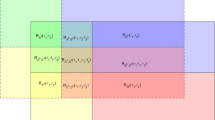This paper discusses the packet error rate (PER) performance of multiple-input multiple-output (MIMO) wireless systems. We focus our discussion on communication systems based on the IEEE 802.11a/g standard. In particular, we study the performance of spatial multiplexing systems with joint encoding at the transmitter and linear detection at the receiver. We show that spatial multiplexing systems based on minimum mean square error (MMSE) or zero forcing (ZF) demultiplexing benefit greatly from antenna subset selection. These results agree with recent analytical results showing the equivalence in diversity order between a full system (all receive antennas) and a system with antenna selection.









Similar content being viewed by others
References
Tarokh V., Seshadri N., Calderbank R. (May 1999). Space-time codes for high data rate wireless communication: performance criterion and code construction. IEEE Trans. Info. Theory 44:744–765
A. Paulraj and T. Kailath, Increasing capacity in wireless broadcast systems using distributed transmission/directional reception. U.S. Patent, 1994
E. Telatar, Capacity of multiantenna Gaussian channels, tech. rep., AT&TBell Lab. Internal Tech. Memo., June 1995
Foschini G. (1996). Layered space-time architecture for wireless communication in fading environment when using multi-element antennas. Bell Labs Tech. J. 1(2):41–59
Win M., Winters J. (Nov 2001). Virtual branch analysis of symbol error probability for hybrid selection/maximal-ratio combining in Rayleigh fading. IEEE Tr. on Comm. 49:1926–1934
D. Gore, R. Nabar, and A. Paulraj, Selectig an optimal set of transmit antennas for a low rank matrix channel, Proc. ICASSP, May 2000
A. Molisch, M. Win, and J. Winters, Capacity of MIMO systems with antenna selection, Proc. Int. Conf. Commun., Helsinki, Finland, Vol. 2, pp. 570–574, June 2001
A. Gorokhov, Antenna selection algorithms for MEA transmission systems, Proc. ICASSP, Orlando, FL, pp. 1926–1934, May 2002
A. Ghrayeb and T. Duman, Performance analysis of MIMO systems with antenna selection over quasi-static fading channels, Proc. Int. Symp. Info. Theory, Lausanne, Switzerland, p. 333, June 2002
A. Gorokhov, D. Gore, and A. Paulraj, (Oct. 2003), Receive antenna selection for MIMO flat fading channels: theory and algorithms, IEEE Trans. Info. Theory, 49:2687–2696
A. Gorokhov, D. Gore, and A. Paulraj, (Nov. 2003), Receive antenna selection for MIMO spatial multiplexing: theory and algorithms, IEEE Trans. Sig. Proc., 51:2796–2807
Barhumi I., Leus G., Moonen M. (June 2003). Optimal training design for MIMO OFDM systems in mobile wireless channels. IEEE Tr. on Sig. Proc. 51:1615–1624
Rappaport T. S. (1996) Wireless Communications, Principles and Practice. New Jersey, Prentice-Hall
G. Strang, (1980) Linear Algebra and its Applications, 2nd ed. Academic Press Inc., New York
A. Gorokhov, D. Gore, and A. Paulraj, Performance bounds for antenna selection in MIMO systems, Proc. Int. Conf. Commun., Anchorage, AL, May 2003




